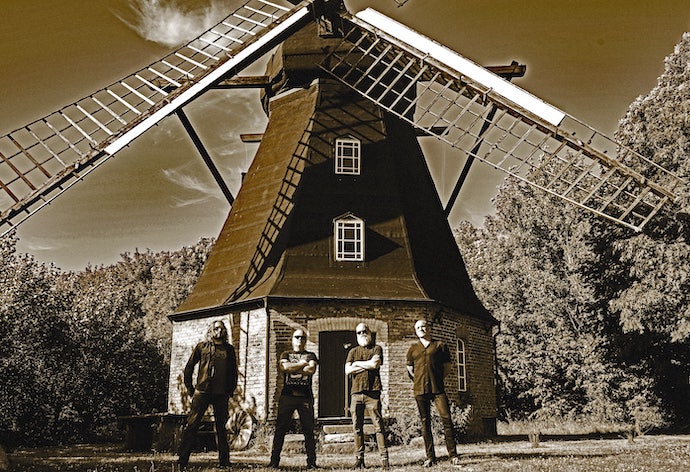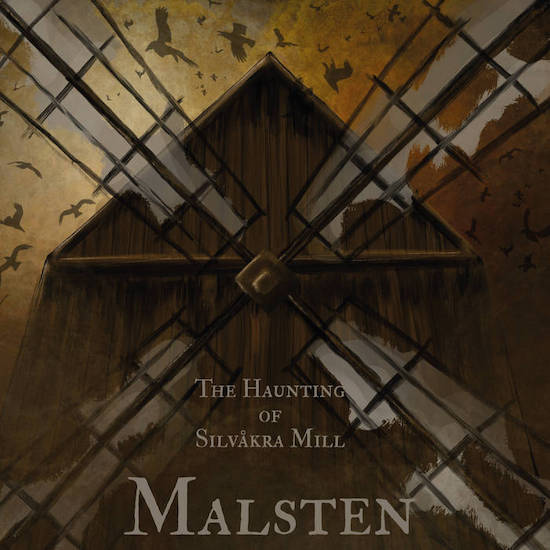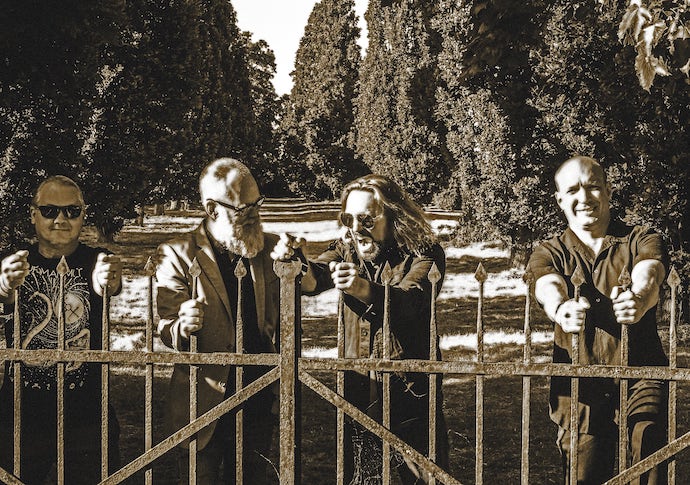
photo by Hedda Winroth
(We present Comrade Aleks‘ very entertaining interview with members of the Swedish band Malsten, whose latest album-length tale of horror was released last month by Svart Records.)
Formed back in 2018, Malsten chose to follow the path of doom, and I’d tell you that they moved pretty fast, having released their first album The Haunting of Silvåkra Mill already in 2020. Four songs, totaling 42 minutes, told a story of bloodshed, evil, horror, and madness in a pretty traditional doom metal manner. The thing about this album was that it’s a concept album with a kind of open ending.
Malsten continued the tale of the Grinder at Silvåkra Mill with two singles, Entr’acte (2022) and Path of the Nix (2024), and as all good things move towards their end, so this story does. Their second album, The Haunting of Silvåkra Mill – Rites of Passage, saw the light of day on March 15this year with the help of Svart Records, and here we are talking with the band about this and that.
Be ready to learn more about grim ways of [folk] horror doom from this quite in-depth and entertaining interview.

Hi Malsten! How are you? What’s going on in the band’s camp?
Hi, we are just fine. There’s a lot going on in the Malsten camp right now. The album The Haunting of Silvåkra Mill – Rites of Passage is up for release on March 15 on vinyl, CD, and digital from Svart Records. We will host a release party in our hometown of Malmö, Sweden, celebrating the album and we have more gigs planned for 2024.
Well, first of all, did you see Malsten as a horror doom band from the start? It’s a kind of unique feature – I mean that the status of “King Diamond of Doom” is vacant, if we won’t take into account the bands influenced by horror movies and Lovecraft.
The first plan with starting up Malsten was to play slow and heavy doom metal, and try to avoid the stoner elements of the genre, getting back to the roots of classic and epic doom metal. Once we had some music written, the idea was formed to have a conceptual approach, as we thought that it would fit the music well. And when it came time to write lyrics, we realized that we needed a good background-setting, so exploring different approaches and after a lot of beers we ended up with the story about the Grinder at Silvåkra mill. So the Silvåkra horror story is not really inspired by horror movies or such, it just came right out of our twisted minds! We would carry the status of “King Diamond of Doom” with pride!
Why did you try to avoid stoner influences? Well, I know indeed, but I just didn’t hear such things for ages.
Honestly, the main reason is that we think it’s boring (stoner is not doom, hahaha). Most bands in the wide doom genre have some form of stoney touch – be it grooves or blues-based riffs. That’s always been the thing that makes our minds wander when listening to a new band. It just feels so over and done. To our tastes, the bands we appreciate most within the doom genres are the ones that keep the stoner elements to a minimum, for instance Ufomammut and Domkraft.
Also, the stoner side of doom doesn’t really fit the ambition of Malsten’s music. We are aiming for conceptual horror doom rather than groovy party music, so to speak.

I found that only Andreas played before Malsten in the Kaptain Sun band. And the first album The Haunting of Silvåkra Mill sounds already damn solid and professional. I can’t believe that Malsten’s other members didn’t play in any bands before – did they?
Fredrik was really into punk/hardcore music in the ’80s. He and some friends, started a punk band in a cold garage – ’83. Since then Fredrik has played guitar in different punk/hardcore bands and some metal-ish bands (Rea Respirator, Palimpsest, Micro Midas, to mention a few), until the year 2000, when he put his guitar on the shelf.
Around 2015 Fredrik was heavily into doom metal and got the idea of playing in a slow and heavy doom metal band, so he started to look for people to do it with. After numerous members and a few years of just writing riffs between Fredrik and Andreas, Malsten came to fruition in 2018.
Manne sang in a folk/jazz band during high school, that’s about it. Well, he is also a master shower-singer.
Stefan started playing in the early ’80s and since then his taste in music is all over the place. He has participated in a lot of different bands, though his main band before taking a break focusing on art and painting was Corroses. They were influenced by punk rock, heavy synth, garage rock, ’70s metal, and in a review after one Maxi-single and a cassette(!) Corroses was labeled; “the first Swedish grunge band”. Stefan recalls: “We had no idea what that meant!”
Did you have a special idea how the band must sound? Was this combination of Candlemass’ epic touch and Ufomammut’s dirty delivery something consciously composed?
We had a somewhat clear idea of what we wanted Malsten to be from the start. Specifically, we knew that heavy, slow and doomy was where we wanted to go. Also, we felt very strongly that a lot of the contemporary doom music lacked substance. Something that we thought that Malsten, as a conceptual horror doom band, could provide.
Between us, we have a lot of very diverse influences spanning from classical music to punk and sludge, and of course – metal. We’ve never really deliberately tried to fuse all these influences into Malsten‘s music, but we like to think that they shine through all the same. Perhaps Malsten‘s wide-ranging influences are easier to spot on the Rites of Passage album than the first The Haunting of Silvåkra Mill album. We wanted to make the new album more dramatic and dynamic, which naturally opened up for a more varied palette of ideas.
It may sound a bit pretentious, but a lot of musical choices come from trying to make Malsten‘s music interesting, both for us as musicians performing it and for the listener. The simplest way of explaining it is perhaps that we pick elements from all our diverse influences and leave out certain aspects that we don’t like so much. We have frequent discussions on what we appreciate and dislike music-wise, and we are almost never in agreement. But that is part of the creative process.
But how do you manage to avoid the whole wide range of influences each member bears after playing in all those bands? It should be natural to get ideas here and there and then to channel it through Malsten?
Oh, surely our diverse influences get channeled through Malsten‘s music. But, we’ve never tried to steer the music in any such direction. Like trying to make a certain track or part of a track more sludgy or punk-oriented. Neither have we deliberately tried to make any parts sound like a classical concerto or opera. Instead we bring our influences into the music in a more subtle way. Some of our riffs share similarities with death- and black-metal, for instance. And Manne‘s vocal melodies rely heavily on folk music influences, both in terms of harmony as well as melodic structure.
How did you compose the concept around The Haunting of Silvåkra Mill‘s original story? I know that there were prejudices about the millers (the Grinder in your case) in the past, like they deal with the devil, and so on. Was it one of the main album’s motives?
The most important aspect for us was the setting of the story in the beginning of the 20th century. From there, the other elements slowly fell into place. Malsten means ‘Grindstone’ in Swedish, so the association to mills and framing the antagonist of the story as a miller known as the Grinder was very natural. The story also plays on mystical themes. But the question mostly posed is whether the supernatural is actually evil itself or an explanation for the evil the men do?
We see the Grinder as a possessed man, but the story of his possession is given without details. Is he just mad? Or is he possessed by some evil powers? Did you aim to leave so much space for listeners’ own imagination?
The best horror stories, be it in the movies or books, are the ones where the audience gets to fill in just the right amount of blanks. Explicit terror is never as scary as the images that your own mind conjures up. So it’s definitely intentional. It’s a fine balance, because you need to give away just enough so that the imagination kicks in. Honestly, it’s always hard to know if it worked or not, you tell us!
Yes, I see your point, and actually it’s a good idea. Recently I was going to watch a movie with a plot built around a question like, “was it all a hallucination or damn crazy apocalyptic shit?” A kind of “unreliable narrator” thing. What’s your favorite book or movie of this kind?
It’s a fairly common dramaturgical technique, so there is plenty to choose from both in literature and film. A classic film that comes to mind is Alien, which also uses silence in the soundtrack very effectively to build suspense.
The original story was left incomplete, like you planned to continue already back then. Did you see its potential from the start?
Yes, we definitely intended the story to be told in two main acts (albums) with an intermission (Entr’acte) in between. The plot was actually sketched to cover two albums from the beginning. But if memory serves, the idea for the single Entr’acte came much later.
Now Malsten’s second album is here, and it seems that the Grinder is back. What’s happening in The Haunting of Silvåkra Mill – Rites of Passage? Did you add new roles in your play?
In Rites of Passage we switch the narrative viewpoint from the Grinder (the antagonist) to the local vicar, Mortimer Aghardt, who decides to hunt down the killer. It is both a physical and a mental journey as he frantically searches the cold and barren landscapes outside Silvåkra whilst battling his relationship with God. One more character is introduced, an ancient being known as the Nix, who works as sort of a spiritual guide for the vicar. We don’t really want to spoil any more of the plot for anyone who might not have listened to the album.
Didn’t you think over the idea to make the album’s edition with some extra illustrations to develop the plot?
It never really came up as an option. But, of course, the doom horror story The Haunting of Silvåkra Mill would be perfect as a graphic novel or animation with the music as a soundtrack. If anyone should be interested in such a project, we would be more than happy to discuss it.
You also released the digital single Entr’acte in 2022. Does it connect both albums with the same plot?
Yes, Entr’acte, tells the story of the protagonist, vicar Mortimer Aghardt’s, wife. She is a tormented soul that kills children who thoughtlessly trample her beloved plants and flowers. Her fate plays an important part in the final album Rites of Passage.

photo by Hedda Winroth
The album’s theme could be summed up like “folk horror”, and here you have an electric fiddle! Did you think to use it more actively on this record, or to increase the folk-element with other measures?
We wanted to add keyed fiddle to the track ‘Path of the Nix’ to get more depth to the introduction, both of the album and the character of the Nix. In Scandinavian and German folklore the Nix is a water spirit that holds hidden knowledge and can serve as a mediator between the seen and the unseen worlds. The character is used in the Silvåkra horror story as a means to portray the rising mental anguish of the protagonist, Mortimer Aghardt.
Martin Aurell, who played keyed fiddle on the track, did an amazing job, both lending a lot of vibe to the track and providing the album with a much needed emotionally charged introduction.
The other quite obvious folk music element is of course Manne’s vocal melodies. That naturally comes from Manne‘s influences. We also had some rudimentary idea to try to make the album a bit more in a folkish direction, with the aim of setting a more melancholic vibe. It fits the story in many ways.
What are your plans regarding Malsten for 2024?
The aim is to do as many gigs as possible, both in Sweden and abroad if possible. Experiencing Malsten and the Silvåkra horror story in live format is a unique experience. The show is energetic and heavy just as a metal show, but also emotionally captivating and thought-provoking. Almost like a classical theater or opera performance.
Do you have some new artistic ideas for live shows? The burning of Manne in the coffin or something?
So far, the options haven’t really been present. But it would certainly fit both the music and our aims with Malsten to put on a grand show with props, other artists or what not. One thing we’ve talked about for a long time is to perform The Haunting of Silvåkra Mill from start to finish, complete with Entr’acte and everything. And if that can come to fruition it would be excellent to put on a grand show.
Okay, thanks for the interview gents. That was my last question. I wish you all the best with Malsten in future.
Enjoy The Haunting of Silvåkra Mill – Rites of Passage and hope to see you on tour in 2024!
https://www.facebook.com/Malstendoom/
https://malsten.bandcamp.com/album/the-haunting-of-silv-kra-mill-rites-of-passage
